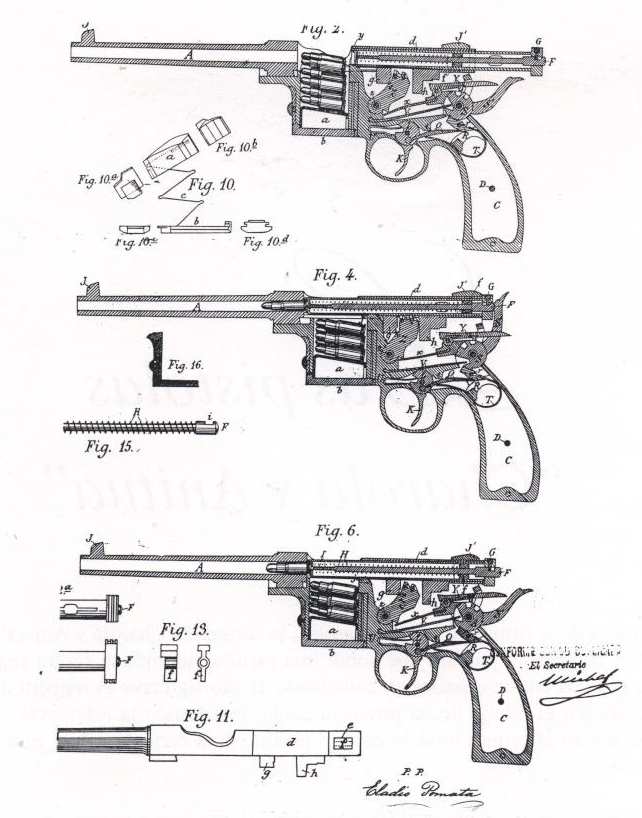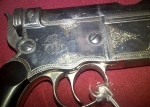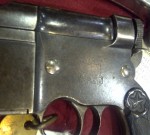The Charola-Anitua is an early Spanish semiauto pistol dating from 1898. The mechanism of the Charola is similar in principle to the Mauser C96, with a moving wedge being used to lock the bolt to the barrel/slide (which is machined as a single unit, like the Mauser). Upon recoiling backwards about 5mm, the wedge disengages, the barrel stops, and the bolt continues recoiling backwards to eject the empty case.

While this principle is similar to the Mauser pistol, the Charola-Anitua is a much simpler design and much cruder in execution, with a simplified locking lug and slide assembly.
The Charola was manufactured in several calibers, including 5mm Clement and 7mm. A total of about 3,000 guns made in 5mm and 2,000 in 7mm. The 5mm used a six-round fixed magazine with stripper clips, while the 7mm was made in both fixed and detachable magazine variants (both types holding six rounds as well).
The 5mm Charola was made in 4 different variants:
- The first accounted for 950 units, with 105mm barrels and marked “PISTOLA AUTOMATICA PATENTE CHAROLA Y ANITUA, EIBAR”, and no caliber markings.
- The second type (900 made) has a 95mm barrel, and marked I. CHAROLA, EIBAR, CAL 5 m/m”.
- The third variation (800 made) has a yet shorter 85mm barrel, and these are marked “BEST SHOOTING PISTOL” on the top of the barrels.
- The remaining 400 guns of the 4th series were made in Belgium.
In 1900, Anitua left the company, and Ignacio Charola decided to produce the 7mm model. The 7mm guns all have 85mm barrels, and the “BEST SHOOTING PISTOL” marking on the barrel. Production of all types ended in 1905.
The 5mm cartridge for the Charola (a sharply tapered bottleneck design) fires a 28 grain bullet at 1030fps, and the 7mm fires a 62gr bullet at 720fps.
Photos
We found a factory engraved 5mm Charola Anitua and a 7mm Charola-Anitua at the Vegas Antique Arms show in 2012, and the owner was kind enough to let us take some photos of both. You can download both galleries at high resolution here:
5mm factory engraved Charola Anitua photos
Resources
A great deal of information on early Spanish pistols can be found on Juan Calvo’s web site, Catalogacion de Armas (in Spanish).















This pistol should be the forerunner of Italian Glisenti of 1913. The locking
principle seems same with it. The Locking Block is rotateably mounted on the Receiver
and not on the Barrel Extention as being of Mauser C96, and propped against to both
Breechbolt and Barrel Extention at different heights as giving different speeds for
both at the rearward travel and therefore, not solidly locking of them, but solely
delaying the separation speed of Breechbolt and Barrel Extention.
Interestingly, this principle is also used on ultra new FN FiveSeven with a description
of “Slightly altered Browning Lock” which is thoroughly incorrect.
A friend of mine recently inherited a late model Charola and Anitua in 7×18 mm. We are looking to source the correct ammunition or perhaps find those with the experience to educate us in to the proper steps in order to manufacture correct ammunition for it. Any information is welcome. Specifically what is the nearest cartridge suitable for a conversion? , and the proper process to follow to reshape said cartridge. Casting the bullet should be fairly straight forward once we make a suitable mold. Surely others out there must have faced the same problem. Photos of the pistol may be seen on my blog here: http://isserfiq.blogspot.com/2012/12/old-spanish-guns.html
Michael
It strikes me as a bit strange that meny of the early semi auto pistols only held six or so rounds. If you were trying to make a gun that beats the revolver then larger magazines make more sence. shurly in a gun fight the man with six rounds is at a disadvantige to the man with eaght or more. So if you want a pistol to better the revolver then give it a higher round count.
At the time reloads and action speed were considered a more pressing matter.
Nice weapon, kinda of a futuristic revolver, by its time pattern.